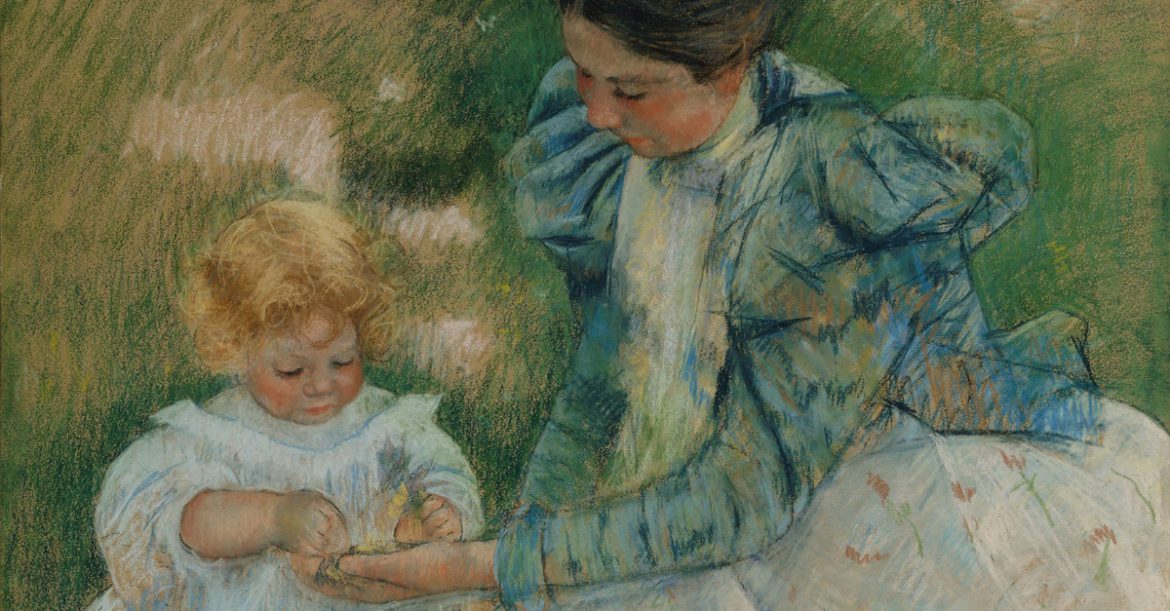Mary Cassatt was an American artist who captured the very essence of maternal love in her tender oil paintings, pastels, and engravings of mothers caring for their children and enjoying simple pleasures, such as reading, crocheting, pouring tea, and picking fruit off a tree. Strangely, her choice of subject matter was the outward manifestation of an independent, forceful, and complex woman who, by choice, never married or had children of her own.
Born in Allegheny City, Pennsylvania, on May 22, 1844, Mary was one of five children to survive infancy of seven born to Robert Simpson Cassatt, a prominent Philadelphia banker, stockbroker, and land speculator, and Katherine Kelso Johnston, the well-educated, intellectually robust daughter of a wealthy banking family. Katherine had a profound influence over her daughter Mary. A friend, renowned art collector and feminist Louisine Havemeyer (1855-1929), observed in her memoirs, “Anyone who had the privilege of knowing Mary Cassatt’s mother would know at once that it was from her and her alone that [Mary] inherited her ability.”
Mary was very young when her family moved to Philadelphia. She began school at the age of 6 and when she was 11 years old, she accompanied her parents on the first of many trips to Europe. Inspired by the art she saw in the museums, she began to draw and paint. By the time she was 15 years old, Mary expressed her desire to become a professional artist. She attended the Pennsylvania Academy of Fine Arts and moved to Paris in 1866 to continue her studies. Women were not permitted to attend the École des Beaux-Arts, so she obtained a permit to copy masterpieces at the Louvre and took lessons from Jean-Léon Gérôme (arguably the world’s most famous living artist at the time), French genre painter Charles Joshua Chaplin, and Thomas Couture, among whose students was Claude Monet.
In 1868, along with New Hampshire-born artist Elizabeth Jane Gardner, Mary became one of the first two American women to exhibit at the Paris Salon. Her work attracted the attention of a circle of young painters that included Gustave Courbet, Édouard Manet, Camille Corot, and Camille Pissarro. Considered radical in their day, they scorned the Academy style. As Mary’s friend, Eliza Haldeman, wrote in a letter to her family, “Artists are leaving the Academy style and each seeking a new way, consequently just now everything is Chaos.”
The Franco-Prussian War erupted in the summer of 1870, and Mary returned to the United States. Her father denounced art as an unfitting career for a young woman who was raised to marry and bring up children. Mary was enraged. She wrote to a friend, “I have given up my studio and torn up my father’s portrait and have not touched a brush for six weeks nor ever will again until I see some prospect of getting back to Europe.” However, in 1874, Mary did return to Paris and that same year, exhibited again at the Paris Salon, where her work caught the eye of a French artist named Edgar Degas.
“Voila!” he exclaimed when he saw Mary’s work. “There is someone who feels as I do!” And when Mary saw his work in the window of a Paris art gallery, she felt the same. “I used to go and flatten my nose against that window and absorb all I could of his art. Degas changed my life! I saw art then as I wanted to see it.”
Ten years Mary’s senior, the couple began an artistic and personal relationship that would last 40 years, on and off, until his death at the age of 83. They had much in common: both came from affluent families, had studied in Italy, had similar tastes in art and literature — and neither was willing to sacrifice their independence on the altar of marriage. Degas mentored Mary, introducing her to pastel and engraving, and fellow artists such as Monet, Pissarro, Renoir, and Cézanne, and soon Mary was accepted as the only woman in the emergent Impressionist fraternity. She embraced their plein air method of painting, using vibrant and individual strokes of color that forced the eye to see the imagery. She exhibited with them, dined with them, and helped them organize their shows.
As a gentlewoman in Paris, Mary could not enter the bordellos or nightclubs to find subjects to paint as Toulouse Lautrec, and other male artists, did. So, she found her own theater — the domestic realm — painting bucolic family life with a subtle palette and soft light.
The 1890s marked the height of Mary’s creative period. She had found a new freedom in the woodcuts by 18th century Japanese artist Kitagawa Utamaro. By 1915, she effectively had turned away from oils, favoring pastels. Then her eyesight began to fail. “I am crushed by the strength of this Art,” she wrote. Crippled by diabetes, rheumatism, neuralgia, and cataracts, she gave up art altogether and lived out her days at Château de Beaufresne. She died June 14, 1926, and is buried in the family vault at Le Mesnil-Théribus, France. Yet her art lives on, capturing the tender love between mother and child as no other artist ever has expressed, before or since.

